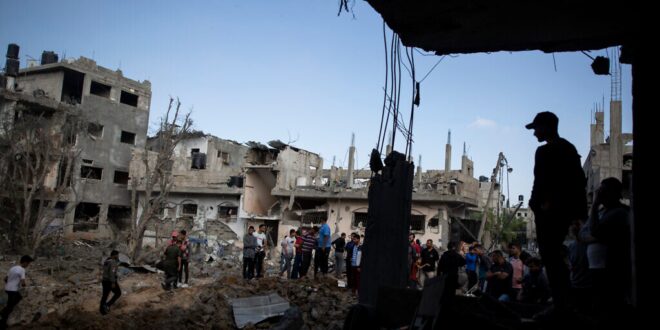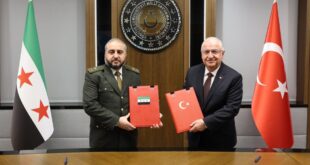The terror group fired its first massive rocket volley on Monday hoping for a quick, decisive exchange. Instead, it dragged beleaguered Gaza into the next Hezbollah war
It’s seven days now into the latest rocket war with Hamas, and the organization has spent the better part of six of them quietly, evasively begging for a ceasefire.
That’s not because the organization is cowed. The opposite. It has already achieved its main strategic goal from the fighting — to sideline Fatah and become the preeminent power within the Palestinian national movement.
Thus, in a phone call on Wednesday with Russia’s Deputy Foreign Minister Mikhail Bogdanov, Hamas’s deputy political chief Moussa Abu Marzouk appears to have been quite explicit.
According to a statement from Russia’s foreign ministry, Abu Marzouk said his organization was willing “to stop any military actions against Israel on a reciprocal basis on the understanding that the international community will exert the necessary pressure on the Israeli side to suppress military actions in the Al-Aqsa Mosque complex.”
Hamas asked for the call, the ministry said.
But less direct appeals came even before Wednesday. On Tuesday, the organization’s political chief Ismail Haniyeh declared “victory” in the fighting, saying, “We have achieved victory in the battle for Jerusalem, the defense of Jerusalem.”
For those not yet inducted into the rhetorical nuances of organizations such as Hamas, declaring victory on day two of what is obviously going to be a longer and more painful altercation amounts to an explicit request to end the fighting.
But just in case the Israeli intelligence analysts listening to his speech missed the point, Haniyeh took pains to add, “Hamas is ready for all scenarios, whether escalation or ceasefire.”
Hamas stumbles in the battlefield
After its initial political triumph in the first day or two of fighting, every day afterward raised the costs for Hamas. With each building demolished in Gaza, Hamas becomes more vulnerable to the accusation leveled by Palestinians in previous rounds of fighting that it had once again dragged the beleaguered territory into yet another military adventure in the service of its own narrow interests.
Hamas took a risk on Monday when it launched the first massive volley of rocket fire at Israeli towns. It saw an opportunity to sideline a weakened Fatah and become the preeminent defender of Al-Aqsa in Palestinian discourse, and it couldn’t resist the temptation.
But it also believed it had prepared well for the new round of fighting. In recent years the organization constructed vast underground tunnels and facilities to protect its forces and other military assets from airstrikes; readied massive barrages of over 100 rockets at a time to overwhelm Iron Dome; and developed clever traps for IDF forces that were supposed to produce “victory images” of destroyed tanks and jeeps.
Over the past six days, those preparations turned out to have been less helpful than Hamas leaders believed.
The IDF’s massive bombardment of that underground infrastructure on Thursday showed Hamas that instead of creating a safe space for its forces, it may have instead created a convenient way to target them without endangering Gaza’s civilians.
Iron Dome has improved over the years. Shootdown rates even in the massive barrages are reported by the IDF to be as high as 90 percent — not enough to reduce the Israeli toll to zero, but enough to ensure Hamas remains incapable of wreaking massive damage to life and limb from the air.
And finally, the IDF has shown it was prepared for at least some of Hamas’s traps. IDF reconnaissance units have identified Hamas anti-tank missile cells as they established themselves behind dunes or in apartments, and have surgically destroyed one after the other. It’s one sign among many of the depth of Israeli intelligence penetration of Hamas’s war efforts. IDF strikes have also repeatedly hit top-secret Hamas facilities and installations.
The first round of the next Hezbollah war
Yet Hamas’s tactical failures pale in comparison to the more fundamental miscalculation revealed in the steady stream of its ceasefire requests beginning as early as the second day of the fighting.
Hamas appears to have believed Israel would seek a quick de-escalation. It was wrong. Israeli political and military leaders could not afford to grant Hamas the quiet it had gambled on.
There are many reasons for that, from Israeli public opinion shocked by the rocket barrages of Monday evening to the belief among Israeli planners, rooted in the past decade of relative quiet, that Hamas can be deterred for years at a time if each round of fighting causes enough damage to the organization.
But there’s another reason, a more fundamental one that has only been tangentially mentioned in the coverage of the fighting, an Israeli calculation that reaches far beyond Gaza’s borders.
The Middle East is watching closely as events unfold in Gaza. Some of the keenest of those observers, Israel knows, are enemies far more dangerous than Hamas.
On Israel’s northern border, Iran-armed Hezbollah sits on a stockpile of rockets and missiles buried in South Lebanon’s towns and villages that dwarfs Hamas’s arsenal by an order of magnitude — a strategic threat bolstered by neverending supplies of ever deadlier missiles from Tehran.
There is a deep link between the Gaza operation and the Lebanese front, a link that has existed between the two theaters at least since the summer of 2006 when a Hamas cross-border attack on IDF soldiers — the abduction of Cpl. Gilad Shalit — escalated into an Israeli operation in the southern Gazan city of Khan Younis. Two weeks later, on July 12, with Israeli forces still operating in Gaza, Hezbollah launched its own deadly attack on an Israeli military patrol on the northern border, sparking what Israelis would come to call the Second Lebanon War.
Israel believes that the Olmert government’s forceful response in 2006 was the reason Hezbollah has declined to test the IDF in a significant exchange of fire ever since.
But both sides have spent the past 15 years upgrading their capabilities, and that hard-won deterrence may be fading.
Hamas miscalculated the Israeli response to its initial rocket fire in part because it did not realize the Israeli response would be geared to ensuring Hezbollah doesn’t make the same miscalculation.
When three rockets were fired from Lebanon on Thursday, landing in the sea off northern Israel, Hezbollah rushed to assure Lebanese media that it had not fired them. Yet the rockets, apparently fired by a Palestinian group, were a potent reminder of the threat. Some Israeli analysts suggested that no Palestinian faction in Lebanon would have launched those rockets without at least the implicit agreement of Hezbollah.
Several incidents in recent days saw Lebanese operatives flying the Hezbollah flag as they rushed the border fence.
On Friday, the Hezbollah-affiliated Al-Manar news outlet reported (Arabic link) that the group’s no. 2, Naim Qassem, had visited the heads of the Lebanese branches of Hamas and Islamic Jihad to praise them for “creating a new equation in Palestine” and to affirm Hezbollah’s belief “that resistance is the solution and there is no solution other than resistance.”
There were more such incidents, none significant on their own but the sum total enough to make some Israeli analysts wonder if Hezbollah isn’t itching to join the fight.
And so, in the fighting in Gaza, the IDF not only sent a message to Hamas by targeting the homes of its leaders, it made sure to broadcast to the world that it had done so — so certain audiences outside Gaza didn’t fail to notice. It has not only demolished buildings that were home to some of Gaza’s wealthiest and most powerful (and, the army assures, also to Hamas installations), but has given plenty of warning before each strike, ensuring both that civilians clear out and that Palestinians catch the strike on camera for the benefit of other elites across other borders.
It announced its targeting of Hamas’s underground bunker system, and released footage of its destruction of Hamas missile squads. The publicizing of the IDF’s capabilities has been intrinsic to the war effort.
Indeed, even the slow, implacable escalation in Israel’s strikes since last Monday is a message, which might be paraphrased thus: “We can do this for a long time. You get to choose when a war begins, but you don’t get to decide when it will end. And you will be paying a higher price at that unknowable end than you were at the beginning.”
Hamas has probably won de facto control of the Palestinian national movement this week. It has shown it can spark unrest in the West Bank and within Israeli society. But it has done so at the cost of transforming beleaguered, struggling Gaza into a proxy proving ground for the next Israel-Hezbollah war.
 Eurasia Press & News
Eurasia Press & News




